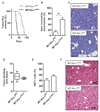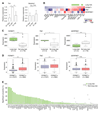Kindlin-1 Promotes Pulmonary Breast Cancer Metastasis
- PMID: 29330144
- PMCID: PMC5857359
- DOI: 10.1158/0008-5472.CAN-17-1518
Kindlin-1 Promotes Pulmonary Breast Cancer Metastasis
Abstract
In breast cancer, increased expression of the cytoskeletal adaptor protein Kindlin-1 has been linked to increased risks of lung metastasis, but the functional basis is unknown. Here, we show that in a mouse model of polyomavirus middle T antigen-induced mammary tumorigenesis, loss of Kindlin-1 reduced early pulmonary arrest and later development of lung metastasis. This phenotype relied on the ability of Kindlin-1 to bind and activate β integrin heterodimers. Kindlin-1 loss reduced α4 integrin-mediated adhesion of mammary tumor cells to the adhesion molecule VCAM-1 on endothelial cells. Treating mice with an anti-VCAM-1 blocking antibody prevented early pulmonary arrest. Kindlin-1 loss also resulted in reduced secretion of several factors linked to metastatic spread, including the lung metastasis regulator tenascin-C, showing that Kindlin-1 regulated metastatic dissemination by an additional mechanism in the tumor microenvironment. Overall, our results show that Kindlin-1 contributes functionally to early pulmonary metastasis of breast cancer.Significance: These findings provide a mechanistic proof in mice that Kindin-1, an integrin-binding adaptor protein, is a critical mediator of early lung metastasis of breast cancer. Cancer Res; 78(6); 1484-96. ©2018 AACR.
©2018 American Association for Cancer Research.
Conflict of interest statement
The authors declare no conflicts of interest.
Figures






References
-
- Driouch K, Bonin F, Sin S, et al. Confounding effects in "a six-gene signature predicting breast cancer lung metastasis": reply. Cancer Res. 2009;69:9507–9511. - PubMed
-
- Landemaine T, Jackson A, Bellahcene A, et al. A six-gene signature predicting breast cancer lung metastasis. Cancer Res. 2008;68:6092–6099. - PubMed
-
- Sin S, Bonin F, Petit V, et al. Role of the focal adhesion protein kindlin-1 in breast cancer growth and lung metastasis. J Natl Cancer Inst. 2011;103:1323–1337. - PubMed
-
- Rognoni E, Ruppert R, Fassler R. The kindlin family: functions, signaling properties and implications for human disease. J Cell Sci. 2016;129:17–27. - PubMed
-
- Has C, Castiglia D, del Rio M, et al. Kindler syndrome: extension of FERMT1 mutational spectrum and natural history. Hum Mutat. 2011;32:1204–1212. - PubMed
Publication types
MeSH terms
Substances
Grants and funding
LinkOut - more resources
Full Text Sources
Other Literature Sources
Medical
Molecular Biology Databases
Miscellaneous

